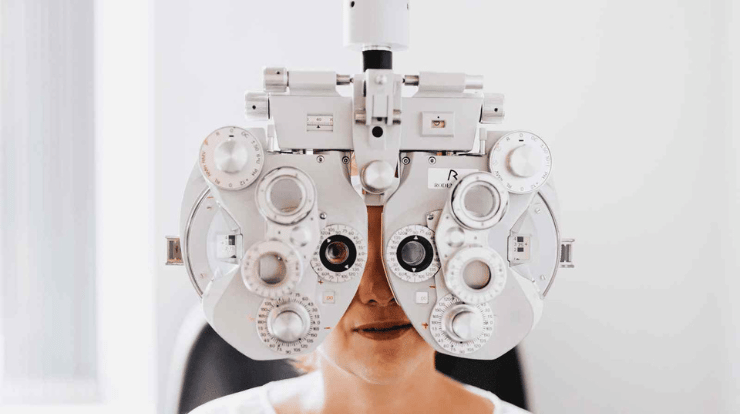
Have you ever had an eye test? For newcomers, visiting the optometrist can be daunting. From knowing how to prepare, to making your way through a series of machine-led tests, it’s no surprise that many of us avoid getting our eyes checked.
In fact, a whopping 65% of the population is overdue for an eye test, according to researchers at Vision Express. As we step into an era of online testing, it has never been easier to get your vision into check.
Not only are eye tests quick and pain-free, but they can also detect potential vision problems before they strike. Did you know that in 90% of blindness cases, receiving precautionary treatment during the early stages of the disease could save your sight?
If that doesn’t inspire you to get your eyes checked, we don’t know what will. Stick with us as we run you through the course of an eye test and reveal four things to expect when you visit the optometrist for the first time.
Are there different types of vision tests?
Not every eye test is the same. Depending on whether you’re visiting the optometrist for a yearly checkup or to address a specific issue with your sight, you’ll undergo different types of eye testing:
- Visual acuity test: This is the most common type of vision test and the one you’ll be most familiar with. Known for testing nearsightedness, farsightedness and astigmatism, this visual accuracy test measures how good your vision is up close, far away and under the influence of light. Using traditional chart tests, and a range of lenses, this form of test is over in about 15 minutes.
- Field vision test: If you’re struggling to see out of the sides of each eye, you may have a problem with your peripheral vision. Eye diseases such as glaucoma can cause what we call ‘Tunnel Vision’. This can be tested by shining a light beam continuously across various areas of your peripherals. The more light you see, the better your field of vision.
Colour blindness test: Colour blindness can be hard to detect. In fact, many of us suffer from it without even knowing.

A colour blindness test consists of viewing shapes and images before circling hidden numbers and letters within them. For those who lack red, green, or blue photoreceptors, it would be almost impossible to pick out these coloured details.
Eye Testing: A step-by-step guide
Whether you’re nervous about your upcoming eye test or are simply curious about the process, we have you covered from the preparation stage to the eye test aftercare, here is a step-by-step play of what you can expect.
The Prep
If you’re heading to a new optometrist, it’s important to prepare for your eye test ahead of the appointment. This includes filling out a patient history form, gathering insurance information, and even remembering to pack your current glasses/contacts.
This will make the process much quicker and give your practitioner a chance to look out for individual changes to your eyes in comparison to your last test. For example, using your current lens prescription as a bar, your optometrist can test whether your glasses are still effective in correcting your vision.
Last but not least, depending on the type of test you’re undergoing, it’s a good idea to enlist a friend or family member to drive you home and keep you safe on the road.
Before the exam
When you arrive for your eye exam appointment, you should expect questions about your current visual health and your general wellness.
These questions range from ‘Have you noticed changes in your vision?’ to ‘Does anyone in your family suffer from a hereditary eye condition?’. The answers to these questions can significantly aid an optometrist when performing an eye exam.
For example, if your family has a history of macular degeneration, your optometrist may focus in on the back of your eye to examine the health of your retina.
During the exam
Once you’ve discussed your medical history, it’s time for the test. The key here is not to worry, as an eye test is often quick and painless.
A traditional eye test will assess your visual acuity and could determine whether your need visual aids such as glasses or contacts. An optometrist does this by asking you to read from those infamous charts both at a distance and up close.
For older patients, you’re more likely to undergo a more in-depth eye examination. From field of vision tests to measuring your eye pressure, optometrists can evaluate the health of your eye using dilating drops. These are painless and simply make your pupils bigger. This makes it easier for practitioners to look behind the eye and test for retinal detachments or identify damage within the optic nerve.

After the exam
Once your exam is finished, the optometrist will determine whether you need any further treatment. This usually comes in the form of glasses. One in three people suffers from either nearsightedness or farsightedness, making it harder to see up close or far away.
While you don’t have to choose your perfect pair of spectacles during your appointment, most opticians have a great collection of glasses of all shapes, sizes and prices.
If your vision tests highlight an abnormality or an increased risk of eye diseases, optometrists may recommend preventive measures you can take to keep your sight in check. For those that suffer from vision struggles, practitioners may also schedule shorter waiting times between appointments in order to monitor any changes.
Getting your first eye test can be scary, but you’re not alone. Staying on top of your visual health could be the key to keeping healthier eyes for longer, so make sure you book that appointment if you haven’t already.

